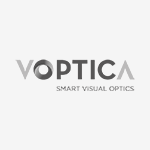Purpose: Light adjustable intraocular lenses (LALs) allow to both correct for refractive errors and to extend the depth of focus by means of controlled amounts of negative spherical aberration (SA). In every patient, improved performance could be obtained by adding specific amounts of SA and residual defocus. We evaluated a customization procedure in each patient where the optimum values of SA were determined with an adaptive optics analyzer before light treatments.
Methods: Eight cataract patients were implanted with LALs (Calhoun Vision, Pasadena, USA). Two weeks after surgery, each patient was evaluated using an Adaptive Optics Vision Analyzer (AOVA, Voptica SL, Murcia, Spain). This instrument permits performing visual testing when controlled optical aberrations are induced into the patient’s eye. The system consists of a wavefront sensor to measure refraction and aberrations, a spatial light modulator to induce any desired phase profile and a microdisplay to present visual stimuli to the patients. Visual acuity (VA) was measured for combinations of residual defocus and SA (in steps of 0.05 microns) with letters presented at infinity, 60 cm, 40 cm and 30 cm. In each patient, optimized values of defocus and SA to maintain adequate near and far VA were determined. Then, the implanted lenses were irradiated with the appropriate spatial intensity profiles to achieve the desired refractive and asphericity targets. After this adjustment procedure, two photo-locking treatments were performed to ensure that the LAL was fixed.
Results: The average values of residual defocus and SA providing an extended depth of focus were around -0.75 D and -0.15 microns respectively. This provided a range of around 2.5 D of depth of focus with VA higher than J2. Individual results varied for each patient and ranged from -0.05 to -0.2 microns of SA. The procedure could also be used to select a different type of LAL treatment (i.e. non aspheric) in those cases where the predicted visual benefit is below a predefined VA threshold.
Conclusions: Light adjustable intraocular lenses and adaptive optics visual analyzers are two novel, complementary technologies. The predicted visual outcomes can readily be implemented in the LALs to, for the first time, provide patients with true customization. The procedure was applied in patients adjusted to produce optimum depth of focus.
Methods: Eight cataract patients were implanted with LALs (Calhoun Vision, Pasadena, USA). Two weeks after surgery, each patient was evaluated using an Adaptive Optics Vision Analyzer (AOVA, Voptica SL, Murcia, Spain). This instrument permits performing visual testing when controlled optical aberrations are induced into the patient’s eye. The system consists of a wavefront sensor to measure refraction and aberrations, a spatial light modulator to induce any desired phase profile and a microdisplay to present visual stimuli to the patients. Visual acuity (VA) was measured for combinations of residual defocus and SA (in steps of 0.05 microns) with letters presented at infinity, 60 cm, 40 cm and 30 cm. In each patient, optimized values of defocus and SA to maintain adequate near and far VA were determined. Then, the implanted lenses were irradiated with the appropriate spatial intensity profiles to achieve the desired refractive and asphericity targets. After this adjustment procedure, two photo-locking treatments were performed to ensure that the LAL was fixed.
Results: The average values of residual defocus and SA providing an extended depth of focus were around -0.75 D and -0.15 microns respectively. This provided a range of around 2.5 D of depth of focus with VA higher than J2. Individual results varied for each patient and ranged from -0.05 to -0.2 microns of SA. The procedure could also be used to select a different type of LAL treatment (i.e. non aspheric) in those cases where the predicted visual benefit is below a predefined VA threshold.
Conclusions: Light adjustable intraocular lenses and adaptive optics visual analyzers are two novel, complementary technologies. The predicted visual outcomes can readily be implemented in the LALs to, for the first time, provide patients with true customization. The procedure was applied in patients adjusted to produce optimum depth of focus.


